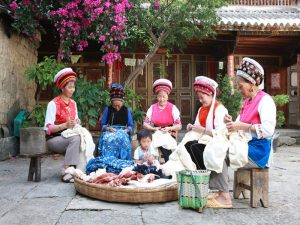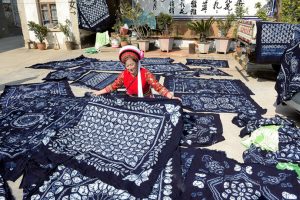 alt="Puer Surrounding Counties and Towns: Weekly & Special Local Markets Travel Guide"
/>
alt="Puer Surrounding Counties and Towns: Weekly & Special Local Markets Travel Guide"
/>
Tie-dyeing Skills of Bai Ethnic Minority in Dali
Brief Introduction
Tie-dyeing, known as “valerian”(絞缬) in ancient times, is an ancient textile dyeing process in China. Dali City, Zhou Town, Xizhou Town(喜洲镇) , Weishan Yi Hui Autonomous County, Dacang(大仓), and other places still retain this traditional craft, of which the Bai ethnic minority tie-dyeing in Zhoucheng(周城白) is the most famous, named by the Ministry of Culture in 1996 as “the home of national tie-dyeing art”. Tie-dyed fabrics are widely used in clothing, home decoration, etc. They have high aesthetic value and practical functions. The products are well received by domestic and foreign consumers, and are one of the main types of export products of Dali.
Characteristics of the Tie-dyeing

Bai People’s tie-dyeing is known as “pimple dyeing” in the folk, that is, before dyeing, the white cloth is overlapped or tightened with needles and threads according to the designed pattern, presenting a “pimple” shape. After repeated impregnation, the untreated “knots” are separated into various flower shapes. The finished products are blue or white flowers with blue background. They are fresh, elegant, unique flavor and very artistic appeal. Tie-dyeing has a variety of varieties, rich patterns and good luck. It mainly includes flowers, plants, birds, animals, fish and insects, patterns and graphics, natural scenery, font symbols and so on. More than 1,000 patterns and patterns contain Bai people’s profound historical and cultural accumulation, reflecting Bai people’s customs and aesthetic taste.
Tie-dyeing Making Process
Tie-dyeing materials are generally white cotton or cotton-linen blended white cloth. The main dyes are plant indigo or Indigo (commonly known as Banlangen板蓝根). The main steps of traditional tie-dyeing include tie-up, soaking, dyeing, drying, thread removal, rinsing and grinding. The key technology of tie-dyeing is tie-up technique and dip-dyeing process. The tie-up process is very complicated. The patterns of each tie-dyed cloth adopt several different tie-up needles, such as tie, pinch, crepe, bundle, wrap, twist, fold, fold, sew and pick. For repeated dyeing, it is necessary to go through many processes, sometimes several days before dyeing a piece of cloth. Besides the number of times of dyeing, the color of the dyed cloth is also related to the dyeing technology, the distribution of dyes, drying, climate and so on. Dyeing cylinder, dyeing rod, drying rack, stone mill and so on are its main tools.
Inheritance and Protection

In recent years, although the prospect of tie-dyeing of Bai nationality is good, there are still some worries about its protection and inheritance, such as: some traditional techniques and tools are gradually being replaced by modern techniques and machinery; plant dye Banlangen has a long planting cycle and a small number of planting, which can not meet the needs of large-scale and industrial development; pollution caused by tie-dyeing; The confusion of market operation and the dilution of folk characteristics need to be further solved.
Chinese Version: http://www.ynich.cn/view-ml-11110-1251.html
Translated by Winnie/张赢

 7 Days GolfingTour
7 Days GolfingTour
 8 Days Group Tour
8 Days Group Tour
 8 Days Yunnan Tour
8 Days Yunnan Tour
 7 Days Shangri La Hiking
7 Days Shangri La Hiking
 11 Days Yunnan Tour
11 Days Yunnan Tour
 6 Days Yuanyang Terraces
6 Days Yuanyang Terraces
 11 Days Yunnan Tour
11 Days Yunnan Tour
 8 Days South Yunnan
8 Days South Yunnan
 7 Days Tea Tour
7 Days Tea Tour
 8 Days Muslim Tour
8 Days Muslim Tour
 12 Days Self-Driving
12 Days Self-Driving
 4 Days Haba Climbing
4 Days Haba Climbing
 Tiger Leaping Gorge
Tiger Leaping Gorge
 Stone Forest
Stone Forest
 Yunnan-Tibet
Yunnan-Tibet
 Hani Rice Terraces
Hani Rice Terraces
 Kunming
Kunming
 Lijiang
Lijiang
 Shangri-la
Shangri-la
 Dali
Dali
 XishuangBanna
XishuangBanna
 Honghe
Honghe
 Kunming
Kunming
 Lijiang
Lijiang
 Shangri-la
Shangri-la
 Yuanyang Rice Terraces
Yuanyang Rice Terraces
 Nujiang
Nujiang
 XishuangBanna
XishuangBanna
 Spring City Golf
Spring City Golf
 Snow Mountain Golf
Snow Mountain Golf
 Stone Mountain Golf
Stone Mountain Golf












 What Our Customers Say?
What Our Customers Say?
